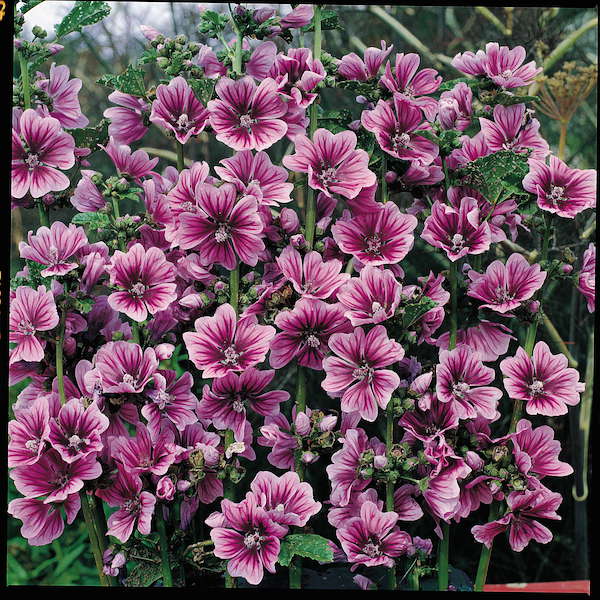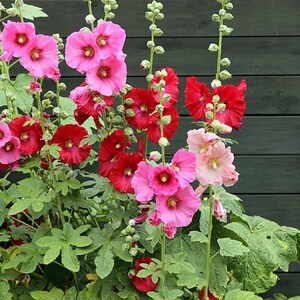

They leave distinctive little squiggly lines all over the leaves. Their leaves are prone to rust if they stay wet too much (which is why some of the most gorgeous hollyhock stands are in the arid Southwest).

Hollyhocks appreciate regular water, but only on the ground. If you do have a rabbit problem, plant your hollyhocks in an area enclosed in chicken wire - the only sure way to keep rabbits away from plants. They don’t seem to bother them, though, when populations are low. When rabbit populations are high, they’ll nibble hollyhocks. This will prevent fungal disease, including rust, from overwintering. But do cut back all the hollyhocks to about the ground level.

Don’t pull them out, even if it’s their second year and they’ve bloomed. In fall, after frost fells the plants, cut them off to just an inch or two. These hollyhocks behave as annuals, blooming the first year, and sometimes also will behave as a perennial, coming back year after year. Hollyhocks also are now available in dwarf cultivars, growing just 30 or so inches high. And just to make things more confusing, some hollyhocks will act like a short-lived perennial and keep blooming for a few years before dying out.īut if you choose the heirloom types that will grow true from seed each year, and allow the flower heads to ripen on the plant, hollyhocks will self-sow and create a stand - like the one by the horse shed - that is a mix of one-year and two-year plants and will bloom beautifully every year. But most are biennials, which means they take two years to mature and bloom, and then they die. Some are annuals (growing, blooming, and dying all in the same year). The trickiest thing about hollyhocks is understanding them. Hollyhocks have long taproots, so if seeds are started indoors, use tall, individual pots and transplant as soon as possible avoid damage. Plant the seeds about 1/4 inch deep and about 1 foot apart (thin to about 2 feet apart after the plants have sprouted). Or you can sow seeds directly in the soil around May 1. Seedlings can be placed outside in late May. Indoors, start seeds no earlier than mid-March. Read label directions carefully or do a quick check online to figure out what kind it is. If you want your hollyhocks to reseed every year, be sure to choose an heirloom cultivar rather than a hybridized type. Also, seed selection is far better than a selection of established plants, so you can choose just the type of hollyhocks you want. You often can find hollyhocks already started at the garden center, but they’re so easy to start from seed, it’s a pity not to. And if you choose the right type, you can - like my grandmother - have a stand of hollyhocks that brings cheer and beauty year after year - maybe even decade after decade.Ĭhoose your seed.
#Direct sow hollyhock seeds full
And they absolutely need full sun, that is, six or more hours of full, unfiltered light a day. They are not fussy about soil, but they don’t like wet spots. Hollyhocks attract birds and butterflies and unlike so many plants, do well even when grown close to a black walnut tree, as long as they get plenty of sun.


 0 kommentar(er)
0 kommentar(er)
